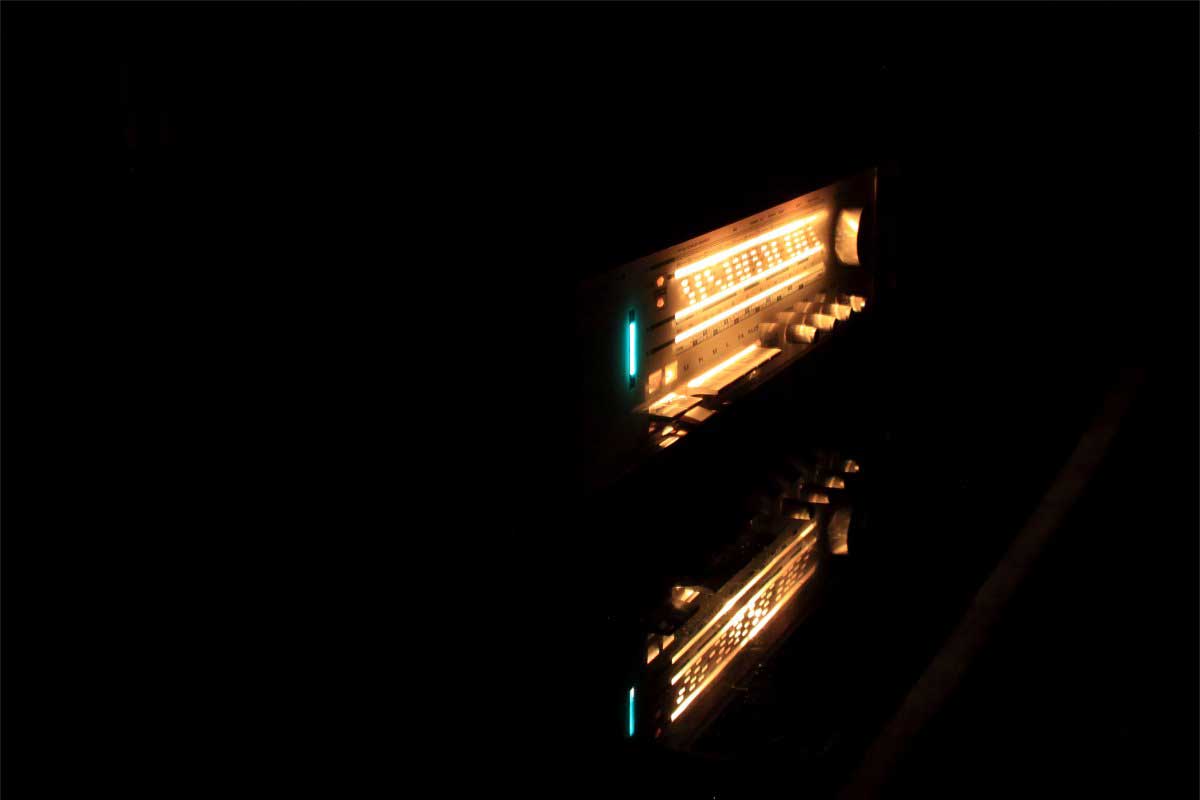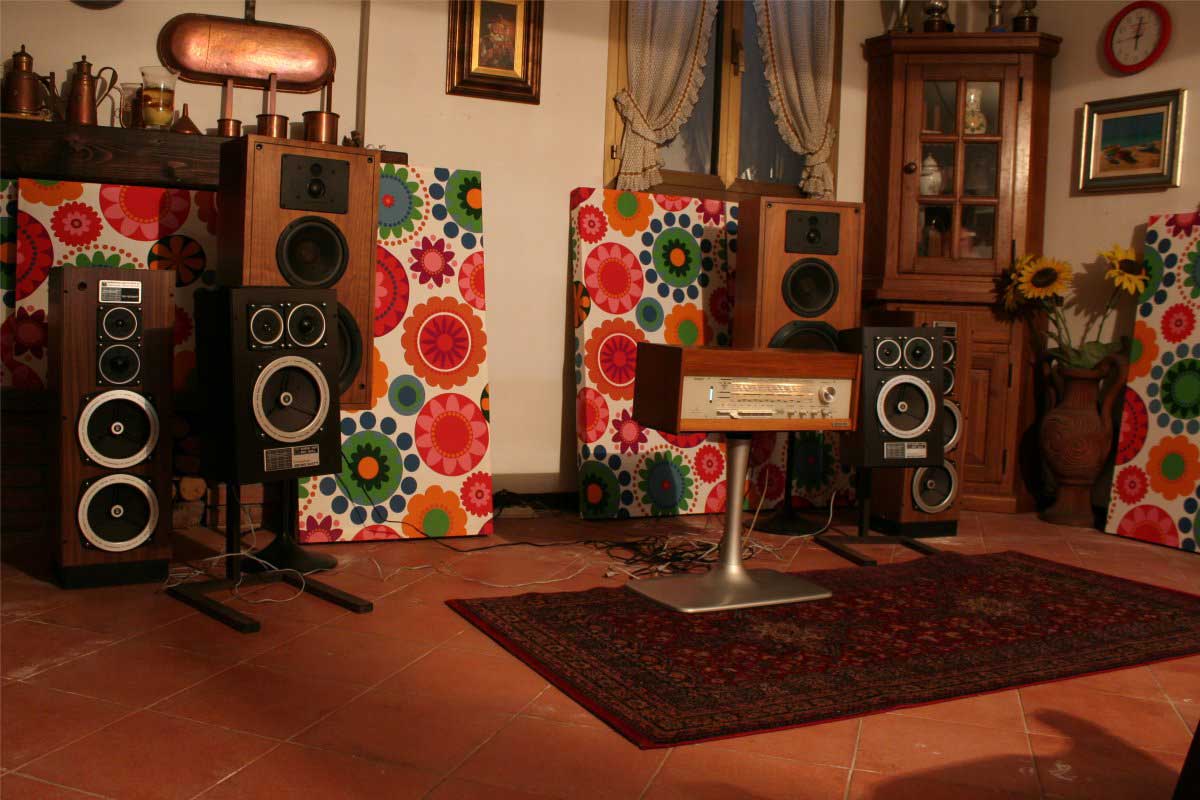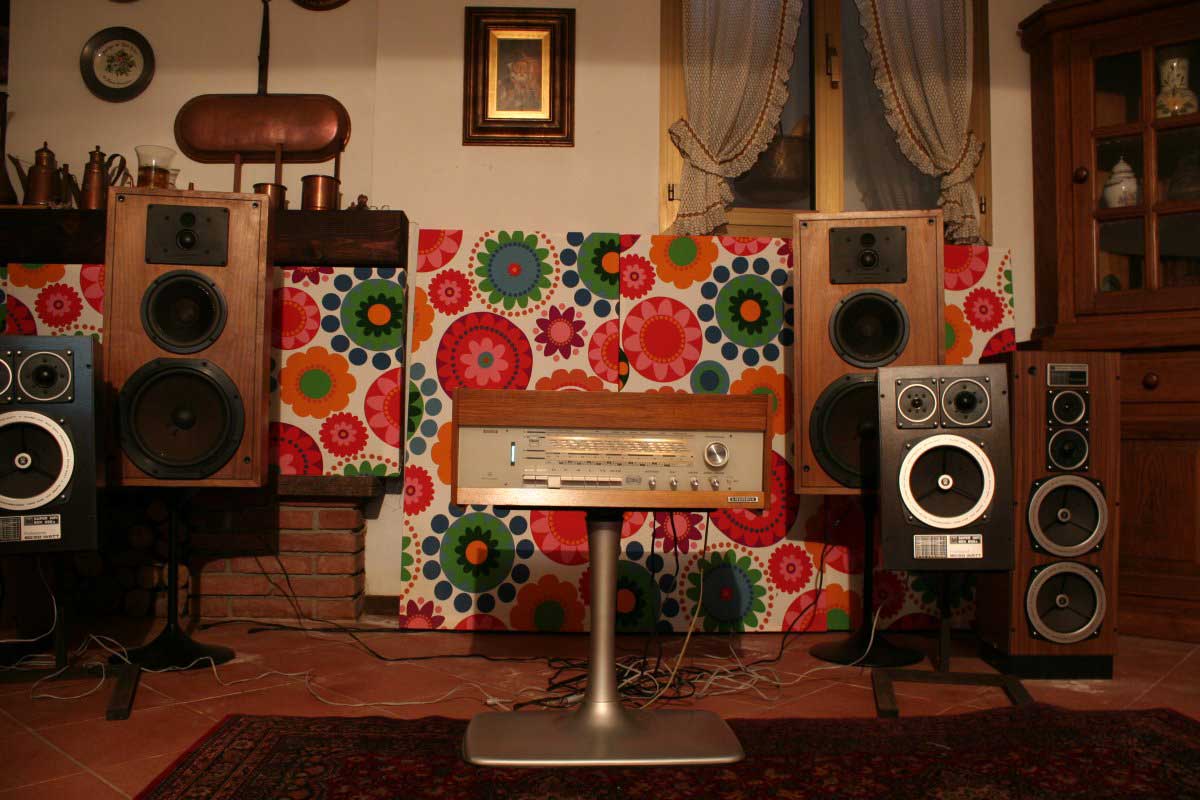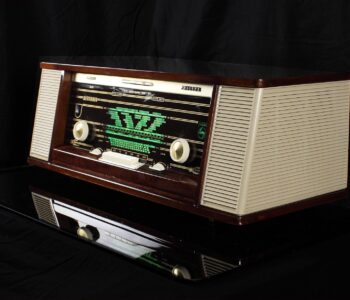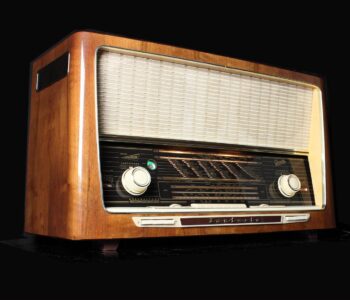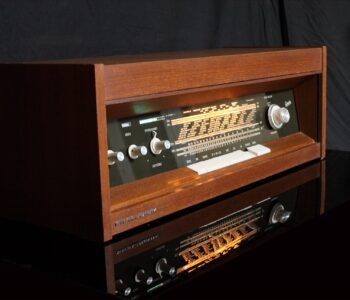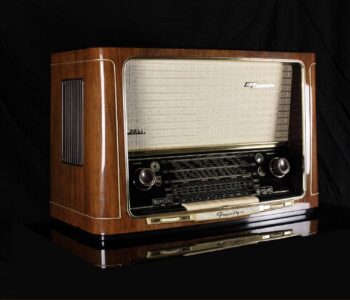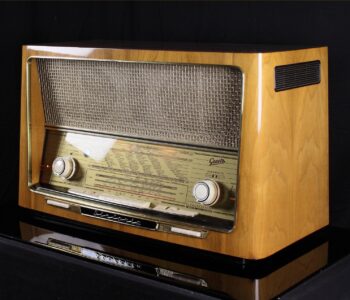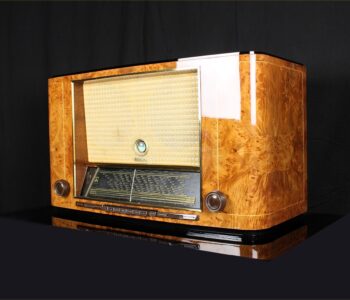 german radios - en
german radios - en
Grundig Stereomeister 15 – en
- by giovanni
Grundig Stereomeister 15
GRUNDIG STEREOMEISTER 15
Despite the look futuristic, for that time, the Stereomeister 15 use only tube circuits.
In this device the original decoder has been replaced with a modern decoder specifically designed. This decoder has a better separation and a lower noise rate than the original one.
The most interesting feature of this model is that the output transformers are bigger than in later models.
I think that also the German industry progressively saved money in their projects.
Transformers larger means less possibility of saturation, deeper bass and lower distortion.
Like others Stereomeister the final stage is a class AB Push-Pull with a feedback circuit for response linearization and distortion decrease.
By employing efficient diffusers the power is more than appropriate even if you want to play the in big spaces.
The response curve changes according to the position of the potentiometer that controls and corrects the volume.
The shift from the section with volume correction to the one with no correction is fairly audible, that is the reason why it is preferable to maintain the volume at a certain level.
The unit is equipped with variable control of the Hall effect.
This refinement has been implemented in order to obtain a depth similar to what you have listening music in a very large room, such as a cathedral.
It's achieved by delaying the sound than the original and remix both.
I discourages the use of the Hall feature. The effect can be pleasant but it is a distortion of the original informations.
Following Grundig’s tradition, the radio section is extremely stable, sensitive and free from ground noises.
Even the final stage is silent and buzzless.
Sound high quality, the stereo decoder and the absence of inner loudspeaker (giving the device a rather modern shape) make of this device a great collector’s piece.
-
BLUETOOTH
Bluetooth receiver embed -
MULTI PLATFORM CONNECTION
Each radio is equipped with a cable for connection to any digital device.
TUBESOUND IMPROVEMENT
- Bluetooth receiver embed - The unit is equipped with a BLUETOOTH receiver powered directly by the receiver power supply. This makes it possible to control the amplifier from any external digital device as an IPAD, a Smartphone, or a sophisticated multimedia station. So you can hear your preferred web station or your lossesless file without cables on the room. Wireless Receiver can be equipped upon requests.
- Multi Platform Connection - A customized adaptation cable to connect any digital device as Iphone, Smartphone, Laptop, CD Player etc. will be provided with this radio. This special cable suits the different impedances between the modern equipment and the receiver. Furthermore the two stereo channels flow into one without increasing the load to the input unit.
HISTORY
1930 - At 22 years old Max Grundig begin a radio repair business.
1939 - The II world War start. Grundig works primarily for the Wehrmacht and repair of telecommunication equipment.
1945 - Immediately after the war, the demand for repair work was very great. Max Grundig built the first two Grundig appliances: the Tubatest tube tester and the Novatest testing device.
1947 - Start the sale of a kit radio, the Heinzelmann. The unit is the basis of success, sold more than 15,000 pieces.
1950 - Very high frequency (VHF) is introduced to Germany and places new demands on the industry. Grundig launches the 380 W on the market.
1952 - The first television channel starts up in Germany. After intensive research, Grundig launches the FS 080 onto the market. In the same year the first portable tape recorder Reporter 500 L is created.
1956 - After a lot of radio produced with progrssively high performances was produced the Concert Radio 5080 equipped with an equaliser, which has five controls and a visual display.
1965 - A new factory is established in Braga, Portugal. The Satellit 205 is one of many appliances in the Satellit series. This product marks the beginning of Grundig production of high-quality global receivers.
1970 - The Audiorama 7000 Hi-fi was produced, it has twelve dynamic speaker systems in one speaker.
1976 - The Reel Tape Recorder TS 1000 is equipped for semi-professional use.
1980 - The slim-line Hi-fi Tuner ST 6000 and the Monolith Hi-fi Dynamic Flat Top Antenna, which has 22 speaker systems, are two particularly popular appliances in the new hi-fi range.
1984 - After severe drop in sales Philips increased its stake in Grundig 31.6 percent and takes over the corporate management.
1997 - Philips pulls out of its involvement with Grundig.
2003 - The company files for bankruptcy.
2008 - Turkey's Koç Holding took full ownership of Grundig Multimedia B.V., the parent company of Grundig Intermedia GmbH in Nuremberg.
Courtesy of: Grundig
MAIN FEATURES
Year of production: 1964
Superheterodyne IF 468/10700
6 AM Circuits
11 FM Circuits
Wavebands:
Medium Waves (OM), Long Waves (OL), Short waves (OC), FM (UKW)
Dimensions (LHD): 22.8 x 9.1 x 8.7 inch
Net weight: 28 lb 10.1 oz
8 Tubes:
ECC85, ECH81, EAF801, 2 x ECC808, EM87, 2 x ECLL800
Decoder stereo
Ferrite Aerial
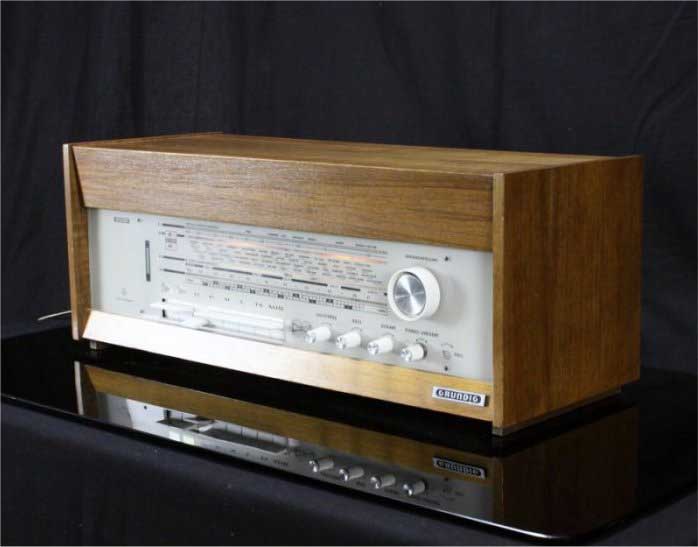
STEREO DECODER
The radio is equipped with a Stereo-Decoder purposely projected and tested for it.
That means it is a real stereo, not like most other vintage radio that used to be mono in the radio FM and stereo sections only because of the double final section.


TUBES
The tubes are ECC85 ECH81 EAF801 ECC808 EM87 ECC808 ECLL800 ECLL800.
The 2 ECLL800 are like of a Push Pull of 4 EL95 with their own preamplifier stages built inside.
AERIALS
Inside the cabinet there is a dipole for FM and an orientable ferrite antenna for AM reception.
The receiving sensitivity with internal antennas is very good.

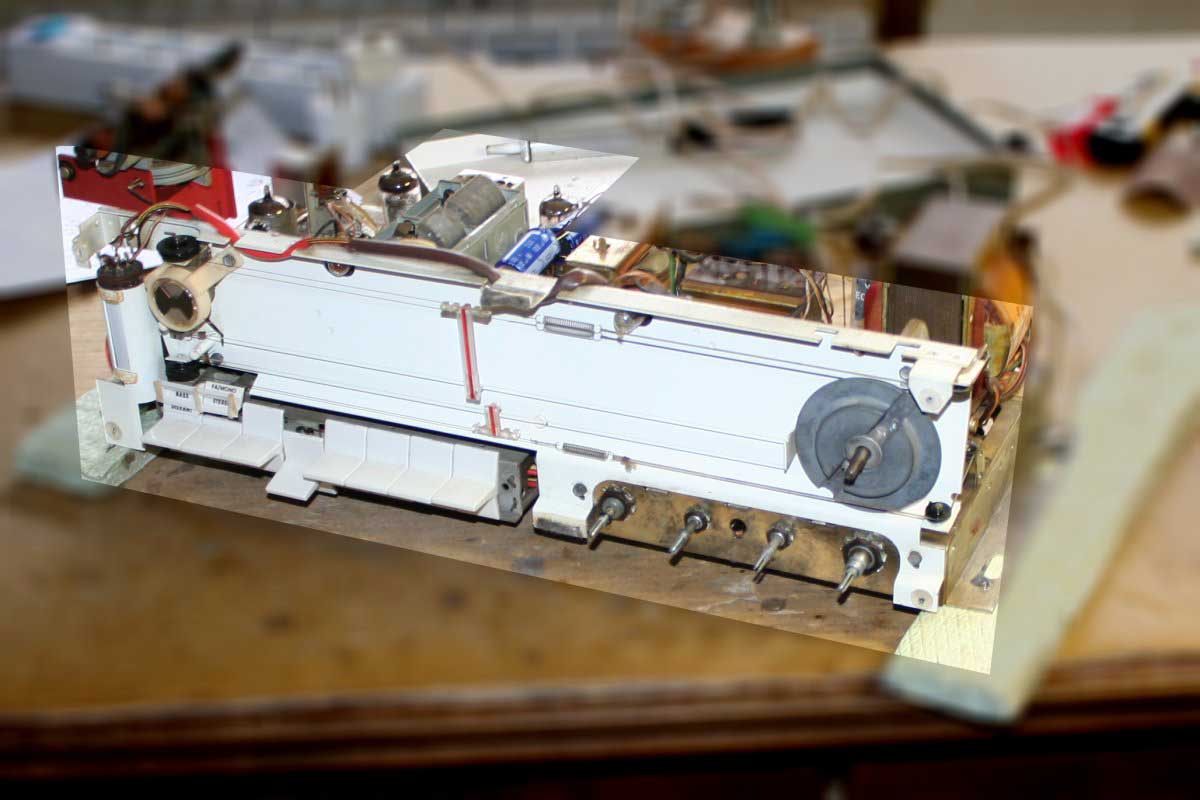
SEPARATE CONTROL TUNING BETWEEN AM AND FM
The tuning system is another gem.
The unit is equipped with mechanisms for keeping separate the AM bands by each of the other two FM bands.
The tuning knob is single but a selector switch commutes into cable systems (all in steel) and pulleys separated depending on the band.


INDICATORS
The stereo FM station indicator

The tuning indicator has of course been replaced.
From the left we find the Bass emphasis switch, the Stereo/Mono switch, the bands selectors, FM, SW, MW, LW, Phono and the OFF switch.
After we find the volume control with loudness built-in, the Bass control, the Treble control, the balance control and coaxially the Hall Control.
On the upper side we find the magic eye that indicates the perfect tuning of each station, the stereo indicator, the AM main display for Long Wave Medium and Court bands, and the FM display.
Finally, there is the tuning knob.
The movement of the tuning knob is very pleasant being supported by a large flywheel.

REAR SIDE
Output for external speakers.
Socket for recorder (tonbandgerat).
Turntable input (Tonabnehmer)
AM and FM aerial inputs and ground socket.
RESTORING WORKS
THE USUAL AMAZING LAST IMAGE







